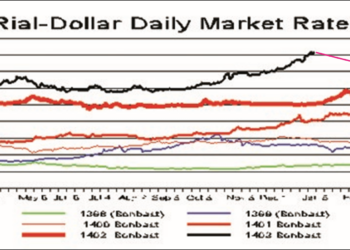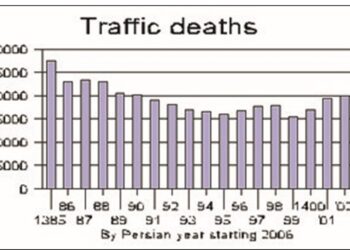.
The problem is a direct result of the American-imposed restrictions on banking in US dollars, which led India’s central bank to stop handling trade payments to Iran.
The Iranian letter threatening to stop supplying oil appears to have been a very unsophisticated effort to goose the Indians into finding a new payment mechanism. When the letter was leaked, Iran promptly denied there was any such letter.
The Saudi offer to step in, however, is a direct threat to Iran’s market share and clearly has Tehran worried. Iran has been selling India an average of 400,000 barrels of crude oil daily. That is almost one-sixth of Iran’s exports. Iran cannot afford to lose India as customer.
The problem started last December when the Reserve Bank of India, India’s central bank, announced it would no longer make payments to Iran under the long-used Asian Clearing House system for trade. Under this system, several countries trade back and forth on paper. Every quarter, the Asian Clearing House nets out who owes whom how much. The Reserve Bank of India would always and up owing Iran because India buys so much oil from Iran—about $14 billion a year now—and sells so little to Iran, only about $1 billion per year.
But under US banking rules, banks can get in trouble if they don’t know what they are paying for. If they dealing with chemicals, military gear, nuclear technology and the like, they may get shut out of the US banking system. Under the Asian Clearing House system, all the Reserve Bank of India got each month was a net payment notice. It had no idea what this covered. So, the Reserve Bank bowed out of dealing with Iran.
A scramble started immediately to find some other payment mechanism. Within weeks, Iran and India settled on the German-Iranian bank based in Hamburg. India made one payment of $2.1 billion through that bank in February before American and French pressure prompted the German government to shut down that route.
Since then, no new route has been found and no more payments have been made. Neither Iran nor India is telling how much of a tab India has run up. It would appear that in the seven months since the Reserve Bank ceased payments, India had received about $8.5 billion worth of oil. Deducting the one payment made would leave a tab totaling around $6.4 billion, a hefty sum. Essar Oil, one of three major Indian buyers at around 100,000 barrels a day pr one-fourth of India’s buy of Iranian oil, announced that as of June 30 it owed Iran about $2 billion.
The Islamic Republic has said next-to-nothing about the payment problem, presumably fearful that if the general public catches word that India is being allowed to run up such a tab, ultra nationalists may throw a fit. Trying to avoid criticism, Mohammad-Ali Khatibi, Iran’s governor or ambassador to OPEC, announced a few weeks ago that there was nothing to fear because Indian buyers have been paying all their debts into an escrow account controlled by the Indian government. But Essar Chief Executive Naresh Nayyar said Essar had been making no such payments and he had never heard about any such account.
Khatibi said Iran was continuing deliveries in order to protect its market share.
Indian and Iranian officials have met repeatedly in search of a solution. None has yet been found, despite numerous officials from both countries proclaiming since January that a solution was in the works and just days away. For example, Iran’s ambassador to India, Mahdi Nabizadeh, announced May 30 that the problem would be solved May 31!
Then last month, the National Iranian Oil Co. (NIOC) sent the three Indian refinery firms that buy most of the oil letters saying Iran could not guarantee any more oil after August if the payment remained unresolved. The NIOC did not say it would stop supplies; it simply said it could not guarantee supplies. Some of the recipients gave the letter to Indian reporters, who characterized the letter as a threat. Iranian officials then backtracked at supersonic speed; some did not merely deny there had been a threat, they also denied there had even been a letter!
Both countries have put considerable effort into finding a payment mechanism. The fact that they have found none after seven months says a great deal about the impact of the US banking restrictions. These have nothing at all to do with the sanctions passed by the US Congress or imposed by the United Nations. The banking restrictions were started in 2005 by US Treasury Under Secretary Stewart Levey.
They are a collection of mechanisms that take advantage of the great influence the US banking system has over world finance. The result is to tie Iran in financial knots. The key to the US effort is the fact that no major bank in the world can continue to be a major bank if it is shut out of contact with the American banking system.
When bankers sit down to debate whether they would prefer to do business with Iran and skip he United States or do business with the United States and skip Iran, that debate generally takes only a nano-second.
Levey’s banking restrictions have turned out to be the most effective of all the schemes the United States has come up with to ensnare the Islamic Republic—by far. President Obama was so impressed with Levey’s success that Levey was one of only a handful of Bush appointees to be carried over into the Obama Administration. Levey recently left the government to return to the private sector.
It isn’t just oil that is impacted. The biggest Indian export to Iran is tea, and the Indian tea industry is wringing its hands over fears it will now lose the Iranian market.
Bloomberg news reported recently that Saudi Arabia contacted Indian buyers last month offering them more Saudi oil and won new sales, according to three sources. Separate news reports have said the Saudis have adopted a harsher policy on Iran and are prepared to use the “oil weapon” by raising their output and selling oil at a discount to buyers who will drop Iran. Bloomberg reported that Saudi Arabia boosted its output in June by 5.1 percent compared with May.













